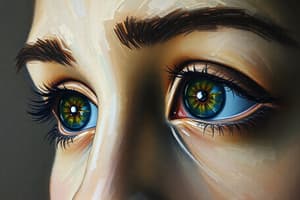Podcast
Questions and Answers
How many recti and oblique muscles are there in the eye?
How many recti and oblique muscles are there in the eye?
4 recti and 2 oblique's
Where is the origin of the recti muscles?
Where is the origin of the recti muscles?
The apex of the orbit from a fibrous ring called "Annulus of Zinn"
Where is the insertion of the recti muscles?
Where is the insertion of the recti muscles?
Inserted to the globe behind the limbus
Where does the superior oblique muscle originate?
Where does the superior oblique muscle originate?
What is the function of the trochlea in the superior oblique muscle?
What is the function of the trochlea in the superior oblique muscle?
Where does the superior oblique muscle insert?
Where does the superior oblique muscle insert?
Which muscles are innervated by the oculomotor nerve?
Which muscles are innervated by the oculomotor nerve?
Which muscle is innervated by the abducent nerve?
Which muscle is innervated by the abducent nerve?
Which muscle is innervated by the trochlear nerve?
Which muscle is innervated by the trochlear nerve?
What is the definition of squint?
What is the definition of squint?
The visual axis passes through the fovea, nodal point of the eye and the point of fixation
The visual axis passes through the fovea, nodal point of the eye and the point of fixation
The anatomical axis passes through the fovea and the center of the cornea
The anatomical axis passes through the fovea and the center of the cornea
What is the angle between the visual axis and optical axis called?
What is the angle between the visual axis and optical axis called?
Pseudostrabismus is a condition where there is a real misalignment of the eyes.
Pseudostrabismus is a condition where there is a real misalignment of the eyes.
What can a large positive angle of Kappa cause?
What can a large positive angle of Kappa cause?
What can a negative angle of Kappa cause?
What can a negative angle of Kappa cause?
A manifest squint is a squint that is only seen when one eye is covered.
A manifest squint is a squint that is only seen when one eye is covered.
A latent squint is a squint that is only seen when both eyes are open.
A latent squint is a squint that is only seen when both eyes are open.
Orthophoria implies a tendency of the eyes to deviate when fusion is blocked.
Orthophoria implies a tendency of the eyes to deviate when fusion is blocked.
Which of the following is NOT a type of latent strabismus?
Which of the following is NOT a type of latent strabismus?
Slight phoria is present in most normal individuals and is overcome by the fusion reflex.
Slight phoria is present in most normal individuals and is overcome by the fusion reflex.
Decompensating phoria can be associated with symptoms of double vision or asthenopia.
Decompensating phoria can be associated with symptoms of double vision or asthenopia.
Which of the following is NOT a possible cause of strabismus?
Which of the following is NOT a possible cause of strabismus?
What type of refractive error can cause latent convergent squint?
What type of refractive error can cause latent convergent squint?
What type of refractive error can cause divergent squint?
What type of refractive error can cause divergent squint?
The Hirschberg test is a light reflex test.
The Hirschberg test is a light reflex test.
The cover-uncover test is used to abolish the stimulus for binocular single vision.
The cover-uncover test is used to abolish the stimulus for binocular single vision.
The alternate cover test is used to assess the corneal reflex.
The alternate cover test is used to assess the corneal reflex.
If the covered eye deviates under the cover and returns to the original position when uncovered, a latent squint is present.
If the covered eye deviates under the cover and returns to the original position when uncovered, a latent squint is present.
The Hirschberg test uses a light to assess the corneal reflex.
The Hirschberg test uses a light to assess the corneal reflex.
In the Hirschberg test, an esotropia is characterized by the corneal reflex being in the same position in both eyes.
In the Hirschberg test, an esotropia is characterized by the corneal reflex being in the same position in both eyes.
Flashcards
What is the visual axis?
What is the visual axis?
The line passing from the fovea, through the eye's nodal point, to the fixation point. In normal binocular single vision, both eyes' visual axes intersect at the fixation point, creating a single image.
What is the anatomical axis?
What is the anatomical axis?
A line passing from the posterior pole through the centre of the cornea. It doesn't always align with the visual axis due to fovea's position.
What is the angle of kappa?
What is the angle of kappa?
The angle between the visual axis and the optical axis. It indicates how the fovea is positioned relative to the anatomical axis.
What is pseudostrabismus?
What is pseudostrabismus?
Signup and view all the flashcards
What is a latent squint (phoria)?
What is a latent squint (phoria)?
Signup and view all the flashcards
What is a manifest squint (tropia)?
What is a manifest squint (tropia)?
Signup and view all the flashcards
What is orthophoria?
What is orthophoria?
Signup and view all the flashcards
What is heterophoria?
What is heterophoria?
Signup and view all the flashcards
What is the medial rectus?
What is the medial rectus?
Signup and view all the flashcards
What is the lateral rectus?
What is the lateral rectus?
Signup and view all the flashcards
What is the superior rectus?
What is the superior rectus?
Signup and view all the flashcards
What is the inferior rectus?
What is the inferior rectus?
Signup and view all the flashcards
What is the superior oblique?
What is the superior oblique?
Signup and view all the flashcards
What is the inferior oblique?
What is the inferior oblique?
Signup and view all the flashcards
What is the oculomotor nerve?
What is the oculomotor nerve?
Signup and view all the flashcards
What is the abducent nerve?
What is the abducent nerve?
Signup and view all the flashcards
What is the trochlear nerve?
What is the trochlear nerve?
Signup and view all the flashcards
What is the Hirschberg test?
What is the Hirschberg test?
Signup and view all the flashcards
What is the cover-uncover test?
What is the cover-uncover test?
Signup and view all the flashcards
What is the alternate cover test?
What is the alternate cover test?
Signup and view all the flashcards
What is esotropia?
What is esotropia?
Signup and view all the flashcards
What is exotropia?
What is exotropia?
Signup and view all the flashcards
What is hypertropia?
What is hypertropia?
Signup and view all the flashcards
What is hypotropia?
What is hypotropia?
Signup and view all the flashcards
How does hypermetropia contribute to squint?
How does hypermetropia contribute to squint?
Signup and view all the flashcards
How does myopia contribute to squint?
How does myopia contribute to squint?
Signup and view all the flashcards
Study Notes
Strabismus
- Strabismus is a condition where the eyes do not look in the same direction
- The anatomy of extraocular muscles is crucial in understanding strabismus
- There are four recti muscles and two oblique muscles that control eye movement
- Recti muscles originate from a fibrous ring around the optic nerve
- Recti muscles insert behind the limbus
- Superior oblique originates above and to the inside of the optic foramen
- It passes through a pulley-like structure called the trochlea
- Then passing backwards and laterally to insert into the upper temporal quadrant of the eye
- Inferior oblique originates from a depression near the orbital rim, laterally to the lacrimal sac
- It passes backwards and laterally to insert into the lower temporal quadrant of the globe
- Medial, inferior, and superior rectus muscles are innervated by the oculomotor nerve
- The lateral rectus is innervated by the abducens nerve
- Inferior oblique is innervated by the oculomotor nerve
- Superior oblique is innervated by the trochlear nerve
Anatomy of Extraocular Muscles
- Four recti muscles and two oblique muscles control eye movement
- Recti muscles originate from the apex (top) of the orbit from a fibrous ring called "Annulus of Zinn"
- Oblique muscles originate in different locations within the orbit.
Innervations
- Medial, inferior, and superior recti muscles are innervated by the oculomotor nerve
- Lateral rectus is innervated by the abducens nerve
- Inferior oblique is innervated by the oculomotor nerve
- Superior oblique is innervated by the trochlear nerve
Types of Squint
- Manifest (tropia): A squint present when both eyes are open
- Latent (phoria): A squint only seen when one eye is covered
- Latent squint is not normally visible with both eyes open but is observable when one eye is covered
- Eso- means inward, Exo- means outward, Hyper- means elevation, Hypo- means depression
- There are various types of latent strabismus or phoria: esophoria, exophoria, hyperphoria, and hypophoria
Etiology of Squint
- Uncorrected refractive errors (e.g., hypermetropia, myopia)
- Congenital weakness of one or more extraocular muscles
- Secondary to other eye diseases (e.g., cataracts, retinoblastoma)
Examination of Squint
- Hirschberg test: assesses the corneal light reflex to check for deviations
- Cover-uncover test: used to detect latent deviation when one eye is covered and then uncovered
Studying That Suits You
Use AI to generate personalized quizzes and flashcards to suit your learning preferences.




